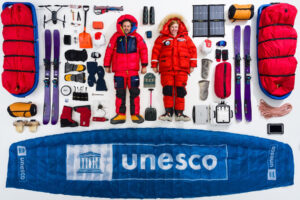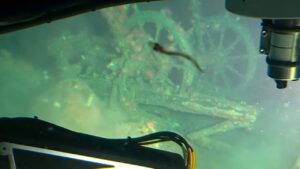Twin Otters location. Former rescue pilot tells about his mission. Mid-winter celebration.
[NSF News updated June 20, 2016, 15:22 EDT to reflect Twin Otter latest location.
See below]
Two Twin Otter aircraft flying an Antarctic medical-evacuation mission have arrived at Rothera, a British Antarctic Survey station on the Antarctic Peninsula, where they will now await favorable weather to fly the roughly 1,500 miles to the National Science Foundation’s Amundsen-Scott South Pole Station.
At Rothera, the aircrews will prepare the aircraft, including equipping them with skis for a landing on snow and ice at the Pole. Once the forecast is favorable, one plane will fly to the Pole to evacuate an ailing member of the station’s winter crew, the other will remain at Rothera to provide search-and-rescue capability, as needed.
Previous
This time of the year, mid-winter is celebrated on Antarctica. The winter solstice marks the turning point of the 6-month polar night at the South Pole. Three months ago the sun set for the last time and will appear above the horizon again only in three months time.
Apart from the total darkness at the Pole, Antarctica’s infamous katabatic winds are still blowing and temperatures can get down to more or less -70ºC at the South Pole Station. The lowest temperature on Antarctica (and Earth) of -136ºF (-93.2ºC) was measured August 10, 2010, near a high ridge between Dome Argus and Dome Fuji, two summits on the ice sheet known as the East Antarctic Plateau.
Currently, Kenn Borek Air’s pilots are about to attempt a medical evacuation at the Geographic South Pole (90ºS).
National Science Foundation Update June 19
On July 14 two Kenn Borek Air Twin Otters were launched from Canada to perform a medical evacuation at the Pole. Yesterday the National Science Foundation gave an update on the position of the Twin Otters:
The two aircraft en route to the National Science Foundation’s Amundsen-Scott South Pole Station, are on the ground in Punta Arenas, Chile. They are awaiting favorable weather to fly to the British Antarctic Survey station at Rothera, where they will prepare the aircraft and await favorable weather to make the flight to the Pole.
NSF is not releasing any further personal or medical information to preserve the patient’s privacy.
Sean Louttit former rescue pilot
In Canada, former Kenn Borek pilot, Sean Louttit, spoke to CBC News. He made this challenging flight to the SP Station twice, once in 2001 and again in 2003, in “similar conditions to what the guys will be facing this week.” The mission is risky but can be done if conditions co-operate, he added. Louttit experienced -67ºC in 2001.
“Navigation works the same as it would in the summer season, but you definitely have that cold temperature you have to deal with and you don’t really know what to expect until you open the door and hit it face on.”
One of the planes will be left at Rothera at the coast of Antarctica while the other one carries on to the South Pole. Louttit says the pilots will carry as much fuel as they can stick in the aircraft. “For that last leg from Rothera to the South Pole, the big concern, of course, is that you don’t have enough fuel to actually go to the South Pole, turn around and come back. Along the route you have a point where you have to make that decision that you’re going to be committed to going to the South Pole and landing there or you turn around and go back to Rothera.”
“Knowing someone’s life could be on the line adds to the pressure but pilots are trained to handle that. You do your job. You put everything else aside, concentrate on what you can control and do it safely.”
NEXT: Kenn Borek pilots at the South Pole (June 21)
NEXT (2): Borek plane left South Pole to Rothera (June 22)
NEXT (3) South Pole evacuation plane at Rothera (June 22)
Previous/Related on Explorersweb/Pythom
Midwinter living on the edge: ExWeb interview with Sven Lidstrom at the South Pole
Kenn Borek South Pole Evacuation Flight Launched
#polar #antarctica #southpole #kennborek #medicalevacuation





